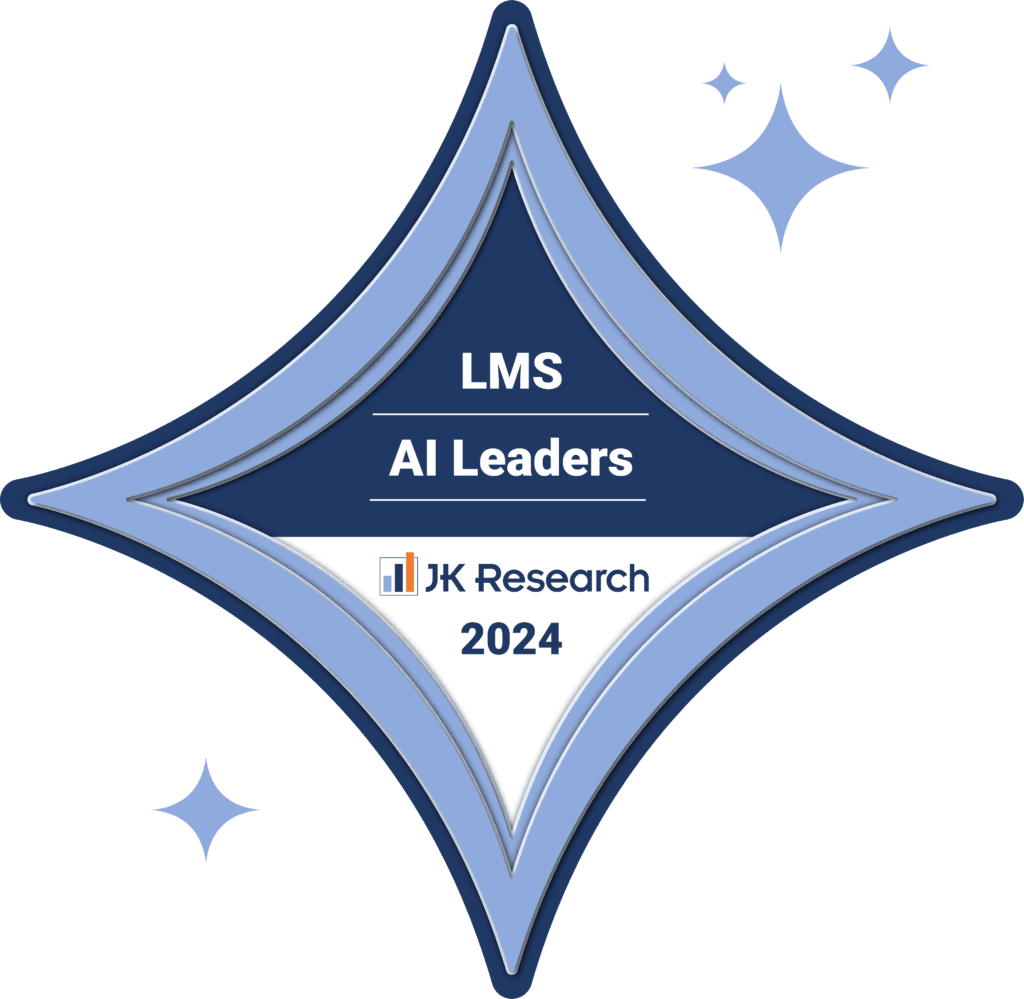Whenever there’s an opportunity for growth, challenges can often come hand in hand with it. 🌱
A recent survey by Deloitte found that 77% of organisations believe L&D is critical to their success, yet only 37% feel prepared to meet the challenges ahead, according to McKinsey. 📊🤔
And as we look towards 2025, if your business wants to stay ahead, you must be prepared to meet the challenges. 🚀⚡
So, with that said, let’s take a look at the top 12 challenges L&D teams are grappling with and what they mean for the future of workplace learning. 📚🔮
1. Keeping Pace with Rapid Technological Change
Technology isn’t slowing down, and neither can L&D.
AI, automation, adaptive learning platforms, and immersive tools like VR are game-changers that have the potential to revolutionise learning experiences. 🤖📈🎮
But integrating these into existing systems?
It’s not just about setting them up and forgetting them…
It requires rethinking your processes, aligning the tools with your organisational goals, and overcoming resistance to change. (Which is very normal!) 🔄💼⚙️
To stay ahead as an L&D professional, you must continuously upskill in emerging technologies, learn how to leverage data effectively, and embrace change management strategies that ensure a smooth transition. 📚🔍✨
If you’re looking for an AI-based learning platform to support your organisation, why not take a look at our comprehensive guide on the
Top 7 AI-Based Learning Platforms For 2025?
2. Improving Learning Transfer
Improving learning transfer is a big challenge for L&D teams, especially considering that only about 12% of employees actually apply new skills they’ve learned during training to their jobs, according to Training Industry. 😲
That’s a pretty huge gap, making it clear why embedding learning into everyday work processes is so important.
This shift is gaining momentum as businesses look for ways to make training more effective and ensure that what employees learn actually sticks with them.
Last year alone, 67% of organisations reported that they were focusing more on continuous learning strategies, and they’re turning to tools like adaptive learning platforms and AI-driven systems to help reinforce knowledge over time (Deloitte’s 2023 Global Human Capital Trends).
And by 2025, companies are expected to lean even more into solutions like micro-learning, on-the-spot coaching, and performance support tools.
This shift will help L&D teams play a bigger role in boosting workplace productivity and keeping employees engaged. 🚀💡
We think you’ll enjoy
What is a Knowledge Gap? (Plus, How to Address Them in 10 Steps)
3. Measuring Learning Effectiveness
Just offering training isn’t enough anymore; you need to prove that it’s actually working. 📊💡
Expect a bigger focus on using analytics to link learning programs directly to important business outcomes like improved performance, better employee retention, and higher productivity levels. 🔍📊
Using data-driven insights, L&D teams can pinpoint which programs provide the best return on investment and adjust strategies accordingly.
It’s all about making sure your training isn’t just busy work but something that genuinely adds value to the company and its people. 📈🔧
4. Aligning L&D with Business Goals
L&D isn’t a standalone department anymore. It’s a strategic partner driving success across your business. 🌟🤝
Designing training that aligns with organisational priorities, such as closing skills gaps, promoting innovation, or enabling digital transformation, has become a top priority. 📈
For example, research by McKinsey indicates that companies focusing on aligning L&D with business strategies report up to 50% higher workforce productivity compared to those without such alignment. 🔄
5. Addressing Skills Shortages
With industries evolving at breakneck speed, skills gaps are one of the biggest hurdles businesses face today.
Upskilling and reskilling are no longer “nice to have” but critical for keeping teams sharp and competitive. 💪
Skills shortages are linked to higher turnover rates and reduced productivity, costing companies billions annually.
By investing in continuous learning and using tools like AI-based skill-matching platforms, companies can tackle these gaps head-on. 📊🤖
Plus, these programs benefit employees too. Studies show that workers who participate in upskilling initiatives are 63% more likely to feel engaged and confident in their roles, according to LinkedIn Learning. ✨
As we always like to say…The right learning culture not only fills gaps but builds a future-ready workforce. 🌟🔧
Why not take a look at our guide on how to identify skills gaps?
6. Creating Personalised Learning Experiences
Gone are the days of one-size-fits-all training sessions. Employees now expect learning that’s as unique as their job roles and career aspirations. 🧑💻✨
This is where AI and data analytics come in as game-changers.
By analysing employee performance, preferences, and progress, these tools can deliver personalised, adaptive learning journeys tailored to individual needs.
For instance, an AI-powered platform might recommend bite-sized lessons for busy employees or advanced modules for those ready to level up. 🤖📊
By 2025, personalised learning won’t just be a nice-to-have, it’ll be a must-have for companies looking to attract and retain top talent.
Whether it’s role-specific training, leadership development, or reskilling opportunities, employees want to learn that meets them where they are and helps them grow. 🌟🎯
7. Engaging Remote and Hybrid Workforces
Remote and hybrid work are here to stay, and that means L&D teams need to adapt.
The challenge?
Creating Learning experiences that captivate employees, whether they’re working from their living rooms, a café, or the office. 🏡☕🏢
The key is creativity in digital delivery.
Think beyond static slides, today’s employees want dynamic, interactive content that keeps them engaged.
Virtual reality simulations, gamified lessons, quizzes, and live webinars with real-time Q&A are just some of the tools leading companies use to make remote learning effective. 🎮🎓💻
In fact, 81% of L&D professionals say they’ve increased their use of digital learning tools since the shift to hybrid work (LinkedIn Learning Report 2023).
And it’s working, interactive content boosts engagement by up to 300%, according to a study by the University of Colorado. 📊🚀
To truly connect, L&D teams must also prioritise flexibility. Bite-sized learning modules that employees can fit into their schedules and mobile-friendly platforms ensure learning happens seamlessly, no matter where they are dialling in from. 🕒📱
8. Creating a Culture of Continuous Learning
Lifelong learning isn’t just a buzzword.
For employees, it’s the key to career growth and relevance.
For organisations, it’s the secret to agility and innovation.
The challenge for L&D leaders?
Encouraging employees to take charge of their development while weaving continuous learning into the very fabric of the workplace culture.💡👩💻
Companies that succeed here see big payoffs. Employees at organisations with strong learning cultures are 92% more likely to innovate and 56% more likely to be first to market (Deloitte). 📊✨
Think micro-learning modules for quick skills, mentorship programs for personal guidance, and platforms that suggest tailored learning paths based on employee goals.🛠️🎯
Employees also need to feel supported. Regular check-ins, recognition for upskilling efforts, and integrating learning into daily workflows can make a world of difference.
7 Ways to Build a Lifelong Learning Culture that Drives Employee Growth
9. Navigating Budget Constraints
Economic uncertainty has tightened purse strings for many L&D teams, but the need for impactful learning hasn’t gone away.
It’s all about doing more with less and doing it smartly.💰🤔
This is where creativity and resourcefulness step in.
Repurposing existing training materials, leveraging free or low-cost digital tools, and prioritising high-impact programs are all ways to stretch those budgets further. 🌟📚
For example, using AI and data analytics can help identify which learning programs deliver the best ROI so resources go where they’ll have the biggest effect.
Collaboration is another secret weapon by partnering with other departments to share knowledge and breathe fresh life into individual teams.
10. Ensuring Diversity, Equity, and Inclusion (DEI) in Learning
DEI has shifted from a “nice-to-have” to a must-have, and rightfully so!
L&D teams must ensure that their programs are inclusive and accessible, address unconscious bias, and foster equity across all training initiatives.
If you’re curious to learn more about DEI training, we’ve created a brand new guide on everything you need to know in 2025 and beyond.
Check it out here. DEI Training: What You Need to Know
11. Preparing for Future Workforce Needs
As more tasks become automated, there’s a bigger emphasis on skills that only humans can offer, like creativity, critical thinking, and emotional intelligence.
These uniquely human qualities will become more valuable than ever. 🌟🧠
According to a report by the World Economic Forum, automation could displace 85 million jobs by 2025 but also create 97 million new roles that focus on human-centric skills.
This means L&D needs to shift its focus from just teaching technical skills to nurturing soft skills that will help employees adapt and thrive. 🤝✨
Companies that get this right are investing in training programs that boost creativity, collaboration, and problem-solving abilities.
Interactive workshops, mentorships, and simulation-based learning can play a huge role here. Plus, with the rapid pace of change, continuous learning will be key to staying relevant. 🏃♂️📚
12. Adapting to Generational Differences
Did you know that workplaces today are a mix of up to five different generations, each bringing their own unique experiences, expectations, and learning styles?
From the tech-savvy Gen Z, who thrive on quick, interactive learning, to the experience-driven Baby Boomers, who prefer detailed, in-depth training, L&D teams face the challenge of making sure everyone feels engaged and included. 🔄💻
One of the biggest challenges is meeting the varied preferences of these generations.
For example, Gen Z is all about fast-paced, mobile-friendly learning and micro-courses they can take on the go.📱💥
On the flip side, older generations often prefer traditional training methods and detailed content that’s easy to reference. 📚🕰️
To tackle this, L&D strategies need to be flexible and diverse.
Offering a blend of learning methods like bite-sized e-learning, video tutorials, hands-on workshops, and one-on-one coaching can cater to everyone’s needs. 🧑🏫
How to Engage Gen Z Learners the Right Way
Final Thoughts
Don’t be deterred.
The challenges of 2025 are significant, but so are the opportunities.✨
It simply depends on which way you look at it.
By embracing technology, personalising learning, and aligning with business needs, L&D teams can thrive and, importantly … survive.
The future of learning is adaptive, inclusive, and transformative… and it’s already here!
Got 2 Minutes?
If your organisation is struggling with disengaged learners, Thirst has the solution.🔥
Thirst is an AI-powered learning platform that helps L&D teams of all sizes boost learner engagement and create experiences tailored to today’s learners.
Take a guided tour today and see Thirst in action.
For more e-learning insights, resources and information, discover the Thirst blog.
You may also enjoy:
What is Adaptive Learning: A Beginner’s Guide | 13 Of The Best Coaching Models to Use | 24 Examples of Employee Strengths and How to Develop Them







